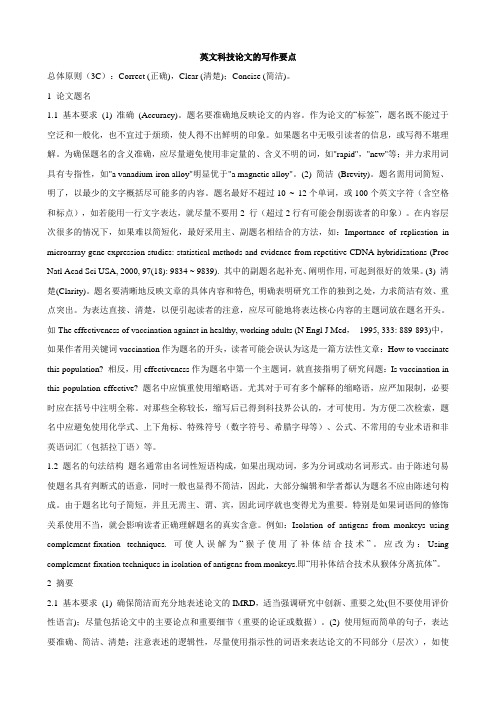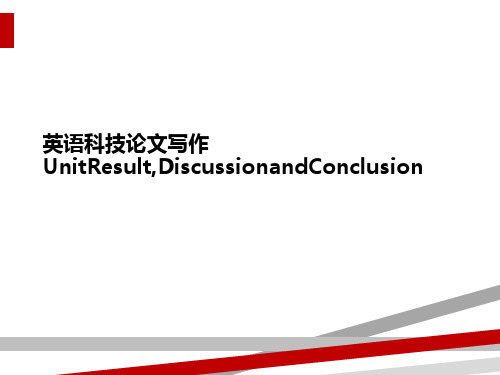英语科技论文写作Unit-8---Result--Discussion-and-Conclusion
- 格式:ppt
- 大小:131.00 KB
- 文档页数:30

英文专八作文模版1. In today's fast-paced world, technology plays a crucial role in our daily lives. From smartphones to social media, we are constantly connected to the digital world.2. However, the over-reliance on technology has led toa decrease in face-to-face interactions. People prefer to communicate through text messages or emails rather than having a real conversation.3. As a result, social skills are deteriorating, and the ability to communicate effectively in person is becoming a lost art. We need to make a conscious effort to put down our devices and engage with others in a meaningful way.4. In addition, the constant bombardment of information from the internet can be overwhelming. It's important to take breaks from the screen and focus on activities that promote mental and emotional well-being.5. Despite these challenges, technology also has its benefits. It has revolutionized the way we work, learn, and connect with others. We just need to find a balance between the virtual world and the real world.6. In conclusion, while technology has its pros and cons, it's ultimately up to us to use it responsibly. We should strive to maintain a healthy balance between the digital world and the physical world, and prioritize genuine human connections in an increasingly digital age.。

英文科技论文的写作要点总体原则(3C):Correct (正确),Clear (清楚);Concise (简洁)。
1 论文题名1.1 基本要求(1) 准确(Accuracy)。
题名要准确地反映论文的内容。
作为论文的“标签”,题名既不能过于空泛和一般化,也不宜过于烦琐,使人得不出鲜明的印象。
如果题名中无吸引读者的信息,或写得不堪理解。
为确保题名的含义准确,应尽量避免使用非定量的、含义不明的词,如"rapid","new"等;并力求用词具有专指性,如"a vanadium-iron alloy"明显优于"a magnetic alloy"。
(2) 简洁(Brevity)。
题名需用词简短、明了,以最少的文字概括尽可能多的内容。
题名最好不超过10 ~ 12个单词,或100个英文字符(含空格和标点),如若能用一行文字表达,就尽量不要用2 行(超过2行有可能会削弱读者的印象)。
在内容层次很多的情况下,如果难以简短化,最好采用主、副题名相结合的方法,如:Importance of replication in microarray gene expression studies: statistical methods and evidence from repetitive CDNA hybridizations (Proc Natl Acad Sci USA, 2000, 97(18): 9834 ~ 9839). 其中的副题名起补充、阐明作用,可起到很好的效果。
(3) 清楚(Clarity)。
题名要清晰地反映文章的具体内容和特色, 明确表明研究工作的独到之处,力求简洁有效、重点突出。
为表达直接、清楚,以便引起读者的注意,应尽可能地将表达核心内容的主题词放在题名开头。
如The effectiveness of vaccination against in healthy, working adults (N Engl J Med,1995, 333: 889-893)中,如果作者用关键词vaccination作为题名的开头,读者可能会误认为这是一篇方法性文章:How to vaccinate this population? 相反,用effectiveness作为题名中第一个主题词,就直接指明了研究问题:Is vaccination in this population effective? 题名中应慎重使用缩略语。



英语专八作文模板范文英文回答:Writing Task 1。
Topic: The increasing use of technology in educationhas both advantages and disadvantages for students. Discuss the advantages and disadvantages of technology in education.Introduction:Technology has become an integral part of modern education, offering numerous benefits and challenges. This essay will examine the advantages and disadvantages of technology in education, highlighting its impact on students.Advantages:Enhanced learning experiences: Technology providesstudents with interactive and immersive learning experiences through simulations, virtual reality, and online tools.Personalized learning: Technology allows educators to tailor lessons to individual student needs, providing targeted instruction and support.Increased accessibility: Online platforms and virtual classrooms break down geographical barriers, making education accessible to students in remote areas.Improved communication: Technology facilitates communication between students, teachers, and parents, enabling collaboration and support beyond the classroom.21st-century skills: Technology use in education prepares students with digital literacy, problem-solving, and critical thinking skills essential for success in the modern world.Disadvantages:Digital divide: Access to technology and digital resources can vary widely, creating an inequality in educational opportunities.Distractions and addiction: Technology can be distracting and addictive, potentially compromisingstudents' focus and engagement.Screen time concerns: Excessive screen time can contribute to health problems such as eye strain, headaches, and sleep disturbances.Lack of hands-on experiences: Technology may limit opportunities for hands-on, experiential learning, which is crucial for some subjects.Social isolation: Over-reliance on technology can lead to social isolation, hindering interpersonal skills development.Conclusion:Technology in education offers both advantages and disadvantages for students. While it enhances learning experiences, personalizes learning, and increases accessibility, concerns arise over the digital divide, distractions, and potential health risks. Educators and policymakers must consider these factors when integrating technology into educational settings to optimize its benefits while minimizing potential drawbacks.Writing Task 2。

讲解第八单元的作文英文英文:In Unit 8, we learned about the topic of environmental protection and conservation. This is a very important issue in today's world, and I believe that everyone should take responsibility for protecting the environment. There are many ways in which we can contribute to environmental conservation, and I would like to share some of them with you.First of all, one of the most effective ways to protect the environment is by reducing our consumption of resources. For example, instead of using plastic bags, which can take hundreds of years to decompose, I always bring my own reusable bags when I go shopping. This simple action can greatly reduce the amount of plastic waste that ends up in landfills or in the ocean.Another important way to contribute to environmentalconservation is by conserving energy. I make sure to turnoff lights and appliances when they are not in use, and I also try to use energy-efficient products whenever possible. For instance, I recently replaced all of my light bulbswith LED bulbs, which use much less energy and last longer than traditional incandescent bulbs.Additionally, I believe that raising awareness about environmental issues is crucial. I often participate inlocal clean-up events and encourage my friends and familyto do the same. By working together, we can make asignificant impact on the environment and create a cleaner, healthier planet for future generations.In conclusion, environmental conservation is a responsibility that we all share, and there are many waysin which we can contribute to this important cause. By reducing our consumption, conserving energy, and raising awareness, we can make a positive difference in the world.中文:在第八单元中,我们学习了关于环境保护和保护的主题。
t8二模英语作文The world we live in today is a rapidly changing one driven by technological advancements and globalization. One of the most significant technological developments of our time is the emergence of artificial intelligence or AI. AI has the potential to revolutionize various aspects of our lives, from how we work and communicate to how we make decisions and solve problems.At its core, AI is the development of computer systems capable of performing tasks that traditionally require human intelligence, such as learning, problem-solving, and decision-making. This technology has been around for decades, but in recent years, it has made significant strides, thanks to the availability of vast amounts of data, increased computing power, and advancements in machine learning algorithms.One of the most promising applications of AI is in the field of healthcare. AI-powered systems can analyze large datasets of medical records, diagnostic images, and research findings to assist healthcare professionals in making more accurate diagnoses anddeveloping more effective treatments. For example, AI algorithms can be trained to detect early signs of diseases like cancer or Alzheimer's, allowing for earlier intervention and better patient outcomes.Another area where AI is making a significant impact is in the realm of transportation. Self-driving cars, powered by AI-based systems, have the potential to revolutionize the way we move around. These vehicles can navigate roads, avoid accidents, and optimize routes, potentially reducing traffic congestion and improving fuel efficiency. Furthermore, AI-powered drones and autonomous delivery systems are transforming the logistics industry, making the delivery of goods more efficient and cost-effective.In the field of education, AI-powered adaptive learning systems can personalize the learning experience for each student, adjusting the pace, content, and difficulty level based on their individual needs and progress. This can help to improve learning outcomes and make education more accessible and inclusive.Beyond these practical applications, AI also has the potential to enhance our creative and intellectual capacities. AI-powered tools can assist artists, writers, and musicians in the creative process, helping them to generate new ideas, refine their work, and even collaborate with the technology. In the realm of scientific research, AIcan be used to analyze vast amounts of data, identify patterns, and generate new hypotheses, potentially leading to groundbreaking discoveries.However, the rise of AI also presents significant challenges and ethical concerns that must be addressed. One of the primary concerns is the potential for AI to displace human workers, leading to job losses and economic disruption. As AI-powered systems become more capable, they may be able to perform tasks more efficiently and cost-effectively than humans, potentially causing widespread unemployment in certain industries.Another concern is the potential for AI to perpetuate or even exacerbate existing biases and inequalities. If the data used to train AI systems is biased or incomplete, the resulting algorithms may reflect and amplify those biases, leading to unfair and discriminatory outcomes. This is a particularly pressing issue in areas like criminal justice, healthcare, and finance, where AI-based decision-making can have significant impacts on people's lives.Furthermore, the increasing autonomy and decision-making capabilities of AI systems raise questions about accountability and responsibility. As AI systems become more complex and opaque, it can be challenging to determine who is responsible for their actions and the consequences they may have.To address these challenges, policymakers, ethicists, and AI researchers are working to develop ethical frameworks and governance structures to ensure that AI is developed and deployed in a responsible and equitable manner. This includes developing guidelines for the transparent and accountable development of AI, as well as exploring ways to mitigate the potential negative impacts of AI on employment and social welfare.Despite these challenges, the potential benefits of AI are vast and far-reaching. As we continue to explore and harness the power of this transformative technology, it is crucial that we do so in a way that prioritizes the well-being of humanity and the planet. By working collaboratively and responsibly, we can ensure that AI becomes a tool for progress, empowerment, and the betterment of our shared future.。
SCI论文结果与讨论写作结果与讨论(Results and Discussion)是原创性论文的结果部分,是描述由科学实验获得的客观结果以及对此结果的评价性认识,旨在交待做出了什么,据此又能得到什么,使有待实践证明的假说、经过科学思维形成的理论认识得到证实,证明作者提出的假说是合理的、科学的,观点是正确的。
结果是研究的直接目标,没有结果,研究就失去依据;讨论是研究的最终目标,没有讨论,结果就停留在表象,研究就失去意义。
一、内容与结构结果与讨论常合并来写,冠以一个总标题(Results and Discussion),也可分开写,有各自独立的标题(Results和Discussion)。
有时还可将“讨论”与“结论”合并为“讨论与结论”或“结论”。
01结果的内容及结构结果是论文的依据部分,是科学研究探索的答案,直接决定了研究工作能否成功、研究目标能否实现。
全文的一切分析、讨论由结果引发,一切推理、判断由结果导出,一切结论、结语由结果得出。
结果的内容及结构通常为:(1)结果介绍,指出结果在哪些插图、表格或相关文本表述中列出;(2)结果描述,描述重要的实验或观测结果;(3)结果评论,说明、解释结果,并与模型或前人结果进行比较。
02讨论的内容及结构讨论是论文的精华部分,对结果进行思考和辩论,给出意见,阐述意义,阐述作者自己的见解,说明与前人结果不同的原因。
重点在于对结果解释、推断,说明结果是否支持或反对某种观点,是否提出新的问题或观点等。
讨论的内容及结构通常为:(1)对主要或重要研究结果、发现的概述,通常先交待研究的目的,再概述最重要的结果与发现,但不与结果简单重复。
(2)对结果内在联系和发展规律的阐释,将实验、观察、研究所获资料、数据及科学界公认的理论、原理作为论据,适引参考文献,围绕结果论证、阐明作者自己的学术观点,从深度和广度达到对结果的进一步认识。
(3)主要研究目的或假设的回顾,充分比较和分析结果,探讨所得结果是否达到预期,如未达到,则要说明原因;将自己的结果与前人的进行比较,如果结果相似,则进一步讨论二者的差别,说明自己结果的新意,但如果相异,也不要断然肯定自己而否定他人。